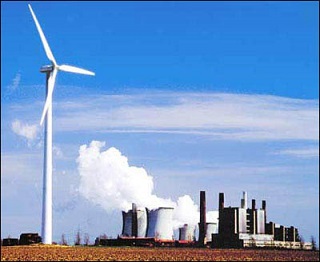From Guest Blogger Lizzie Weakly: Solar vs. Wind–Which Generates More Power?

Two Unique Power Sources
By absorbing light into ground-mounted modules, or panels, it’s possible to convert the sun’s rays into direct current electricity. From there, inverters built into electrical panels turn direct current electricity into the alternating current electricity needed for homes and businesses. If the process generates more power than it uses, it can sends electricity back through the utility meter. As a result, those that are willing to invest in solar energy will effectively negate their power bills at some point, which can help offset the price of the panels.
A good wind turbine can theoretically provide the same benefits. Wind that blows past the blades makes the rotor and the main shaft spin, which in turn rotates a generator to make electricity. While they typically need to be set higher above the ground to work effectively, wind turbines can potentially generate two megawatts of power. That’s enough electricity to power more than 2000 homes, but it comes at a cost.
The Circumstances of Power
To get the most out of a wind turbine, it needs to be able to reach at least eight meters above ground, catch winds that move roughly 12 miles per hour, and not have any interference from birds or debris. Wind farms across the United States can meet those requirements, but it’s impractical to expect the same of the average suburb. The wind’s sporadic nature and obstructions caused by neighbors can hamper a turbine’s output, and it can’t be mounted to the roof of a house. Additionally, a turbine can fail completely if it’s set in a region without sufficient wind.
When it comes to solar vs. wind, the former may not always generate massive amounts of electricity, but it compensates with consistency. Modules will still work on cloudy days, for example, and can be placed in more areas without a hassle. They still require occasional cleaning and maintenance, but they can serve homes as well as businesses. A case study run by Inland Power and Light showed that solar panels could reliably produce 15% of a Spokane home’s electricity over a year. Wind turbines in the same situation couldn’t even generate 3%.
It’s worth remembering that wind energy still has its place. As a clean and renewable resource, it’s proven its potential as a means to provide electricity for a vast number of users. It can excel, but only if the turbines are of the proper form and placed in the right location. Wind power is thus ideal for large scale operations and economic sectors, but it lacks the pure versatility of solar power. If gathered in a large enough group, its panels can also provide a fair bit of energy. As long as those panels are installed in places where it’s guaranteed to absorb light, it works for both large-scale companies and small-scale residences. There’s no ironclad winner, but solar and wind energy alike can promote greener living.
